Camponotus (Orthonotomyrmex) sericeus (Fabricius)
  Type location Senegal
(Formica sericea, in Fabricius, 1798: 279, worker; Mayr, 1866b:
886, queen, Sudan, Khartoum; Forel, 1886f: 192, male, Egypt; Forel,
1891b: 56,
all forms)
collected by Bosc - no images on Antweb (September 2014) Type location Senegal
(Formica sericea, in Fabricius, 1798: 279, worker; Mayr, 1866b:
886, queen, Sudan, Khartoum; Forel, 1886f: 192, male, Egypt; Forel,
1891b: 56,
all forms)
collected by Bosc - no images on Antweb (September 2014)
subspecies sulgeri (Camponotus
(Orthonotomyrmex) sericeus Fabr. var. Sulgeri n. var., Santschi, 1913c:
313,
worker) Congo, collected at Brazzaville, by A. Weiss - see below
junior synonyms
aurulenta (Formica
aurulenta, Latreille, 1802c: 114, illustrated,
queen) Senegal - no images on Antweb (September 2014)
All forms known.
|
Fabricius' (1798) description is at  . Latreille's (1802c)
description of the queen, as aurulenta, is at . Latreille's (1802c)
description of the queen, as aurulenta, is at  . Lepeletier de
Saint-Fargeau (1835: 213) gave a description, this is at . Lepeletier de
Saint-Fargeau (1835: 213) gave a description, this is at  . Mayr (1862: 675) gave a
description of the Egypt and eastern form, this is at . Mayr (1862: 675) gave a
description of the Egypt and eastern form, this is at  . Mayr's (1866b: 886) description of the
queen is at . Mayr's (1866b: 886) description of the
queen is at  . Forel's (1886f)
description of the male from Egypt is at . Forel's (1886f)
description of the male from Egypt is at  . Forel (1891b: 56)
provided a description and notes which seem to blanket both the sericeus
ss and obtusus forms, this is at . Forel (1891b: 56)
provided a description and notes which seem to blanket both the sericeus
ss and obtusus forms, this is at  . Arnold (1924: 709-710) provided a
description and notes, this is at . Arnold (1924: 709-710) provided a
description and notes, this is at  . .
Note - With fresh specimens, I have removed the
following Santschi (1926b) forms to Camponotus
obtusus - v obtusus Sm. - head red; alitrunk variable
black or red; legs brown; pubescence somewhat golden; petiole, scale
less thick at summit [from Egypt, Port Said by Karavaiev; from Obok, by
Maindron, 1893; and from Jansuame, Sahara, Iferouman Region, by Mission
Fourreau-Lamy, 1900)
and, Camponotus
euchrous (Camponotus (Orthonotomyrmex) sericeus F. v. euchrous
n. var., Santschi, 1926b: 267, queen) from French Sudan
[western Sahel; not modern Sudan, as given by Bolton, 1995] -
head, alitrunk and appendages red often quite bright; more slender;
petiole scale higher; gaster black; pubescence greyish yellow.
|
 Emery
(1895k) noted peguensis
(photomontage below) from the form of the alitrunk as close to C. opaciventris Mayr, longer than
the true sericeus; the whole
body clothed with ashy pubescence, denser and shiner on the gaster; the
erect hairs more numerous than the type form; the scape and legs with
numerous short whitish hairs. Colour black, with the mandible,
antennae and legs dull ferruginous brown; otherwise with no important
characters. From comparing the sulgeri
type minor and the peguensis minor (for that
it is what it seems to be) it is obvious that peguensis is a very distinct
species. Camponotus peguensis (C.
sericeus Fab., subsp. peguensis
n. subsp., Emery, 1895k:
479, minor worker) Myanmar (Burma) - see http://www.antweb.org/specimenImages.do?code=casent0905412. Emery
(1895k) noted peguensis
(photomontage below) from the form of the alitrunk as close to C. opaciventris Mayr, longer than
the true sericeus; the whole
body clothed with ashy pubescence, denser and shiner on the gaster; the
erect hairs more numerous than the type form; the scape and legs with
numerous short whitish hairs. Colour black, with the mandible,
antennae and legs dull ferruginous brown; otherwise with no important
characters. From comparing the sulgeri
type minor and the peguensis minor (for that
it is what it seems to be) it is obvious that peguensis is a very distinct
species. Camponotus peguensis (C.
sericeus Fab., subsp. peguensis
n. subsp., Emery, 1895k:
479, minor worker) Myanmar (Burma) - see http://www.antweb.org/specimenImages.do?code=casent0905412.
Santschi
(1913c) gave a very brief note on sulgeri
as smaller than the type and with sparser pubescence, also a somewhat
longer and more concave propodeum.
Santschi (1926b) had - the type is entirely black, the pelt of
pubescence is greyish yellow; the pelt is missing in var. sulgeri;
from Ivory Coast at Dimbroko by Lemoult, Dahomey, at Kouande by Desanti
(Benin) and Casmance by Claveau.
Wheeler (1922) included an illustration of a worker
(full profile and full-face head), showing it to be characterised by a
concave posterior face to the propodeal declivity and a cuboid petiole
(otherwise it resembles Camponotus vividus). He listed findings
from widely across
sub-Saharan Africa.
Santschi (1929c) noted that it had been found by de
Peyerimhoff at Hoggar, Tamanrasset, Algeria, i.e. in the centre
of the Sahara Desert, 6 to 10.iii.1928, 4 minor workers.
Its use of chemical signals in recruitment for
tandem-running was studied by Hölldobler and colleagues (see Bradshaw
& Howse, 1984).
Listed as a savannah species in Ivory Coast by
Lévieux & Louis (1975). Lévieux (1978, 1983a), noted its presence
(or a close relative) in savannah, at Ferkéssédougo, where it was
preyed on by Myrmicaria opaciventris (as nitidans).
|
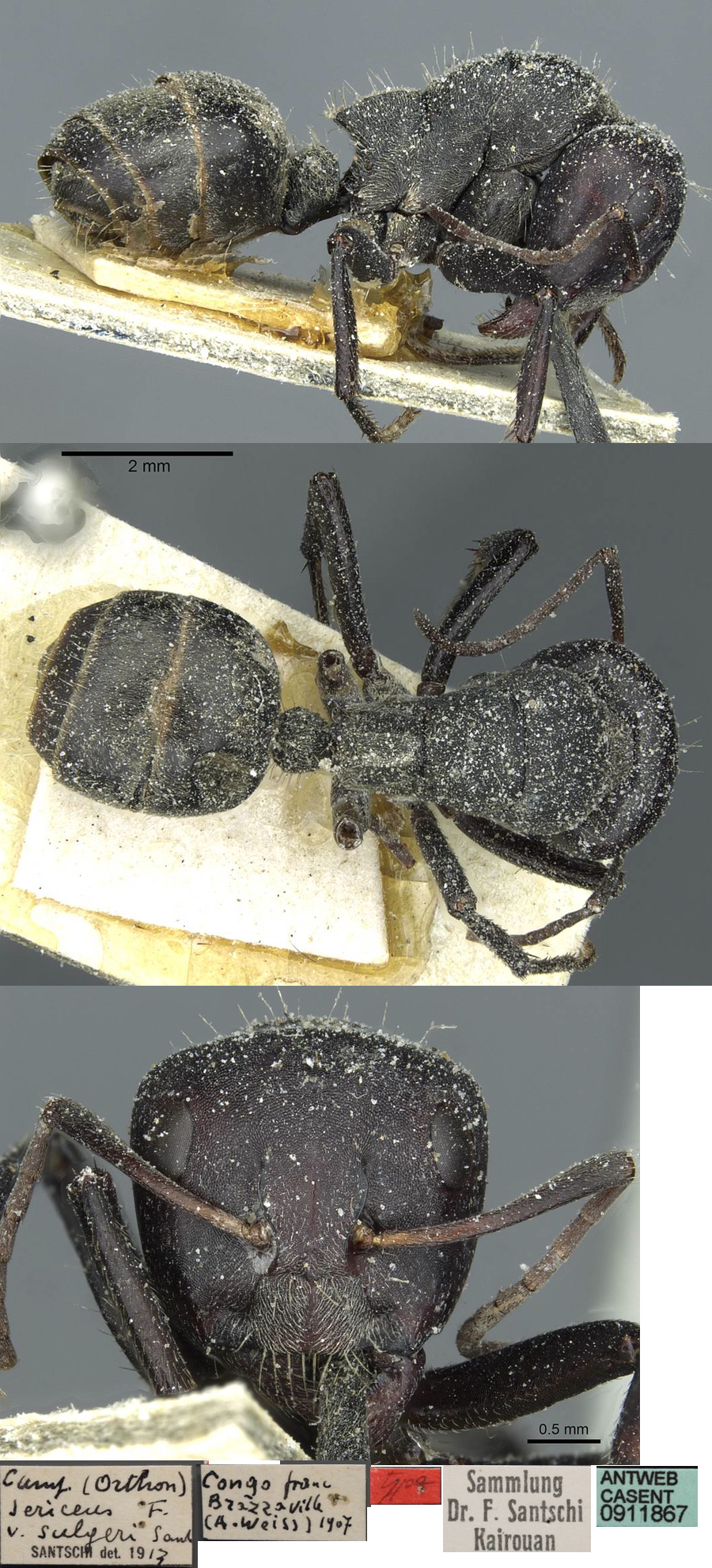 The photomontage of
the sulgeri type major is collated from http://www.antweb.org/specimen.do?name=casent0911867. The photomontage of
the sulgeri type major is collated from http://www.antweb.org/specimen.do?name=casent0911867.
|
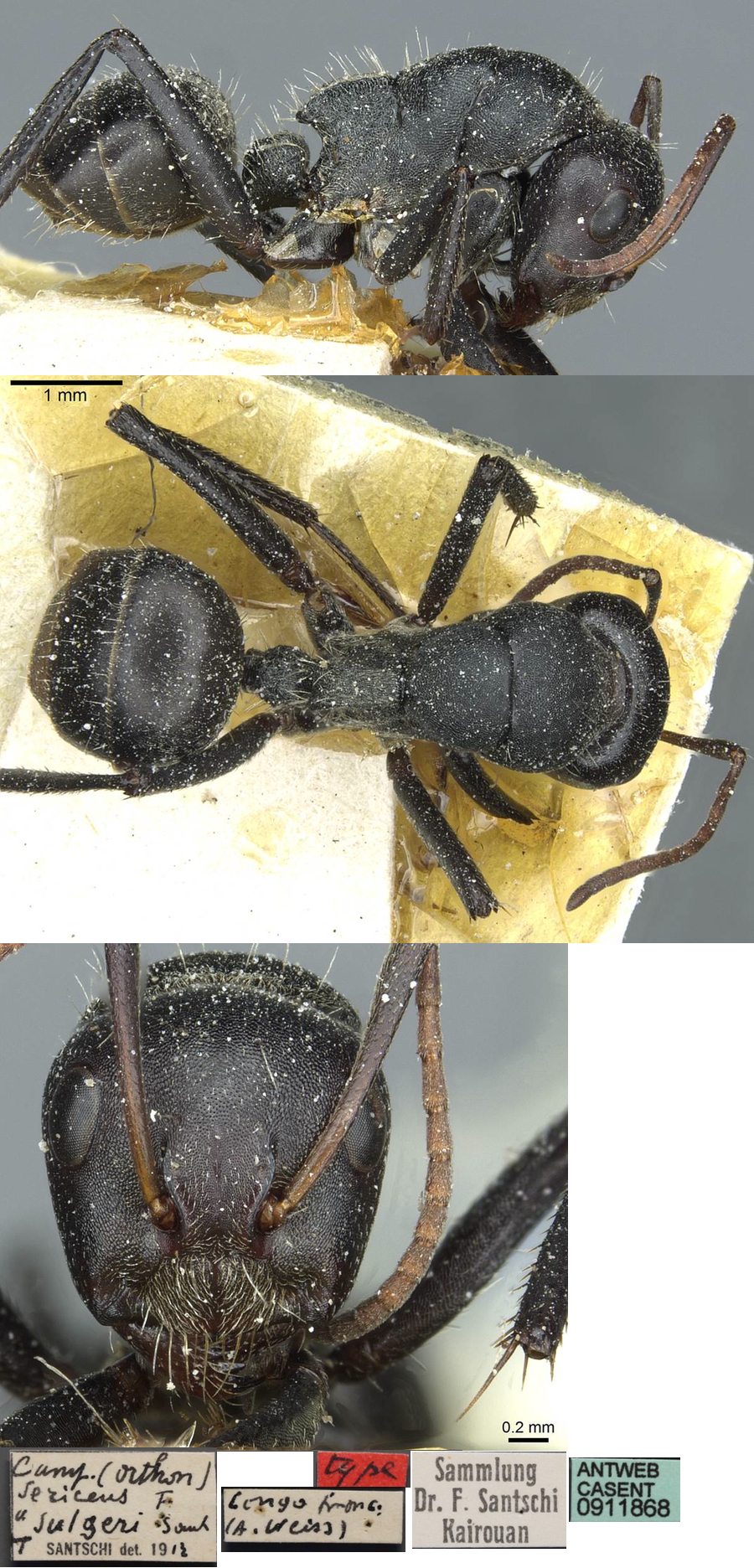 The photomontage of
the sulgeri type minor is collated from http://www.antweb.org/specimen.do?name=0911868. The photomontage of
the sulgeri type minor is collated from http://www.antweb.org/specimen.do?name=0911868.
|
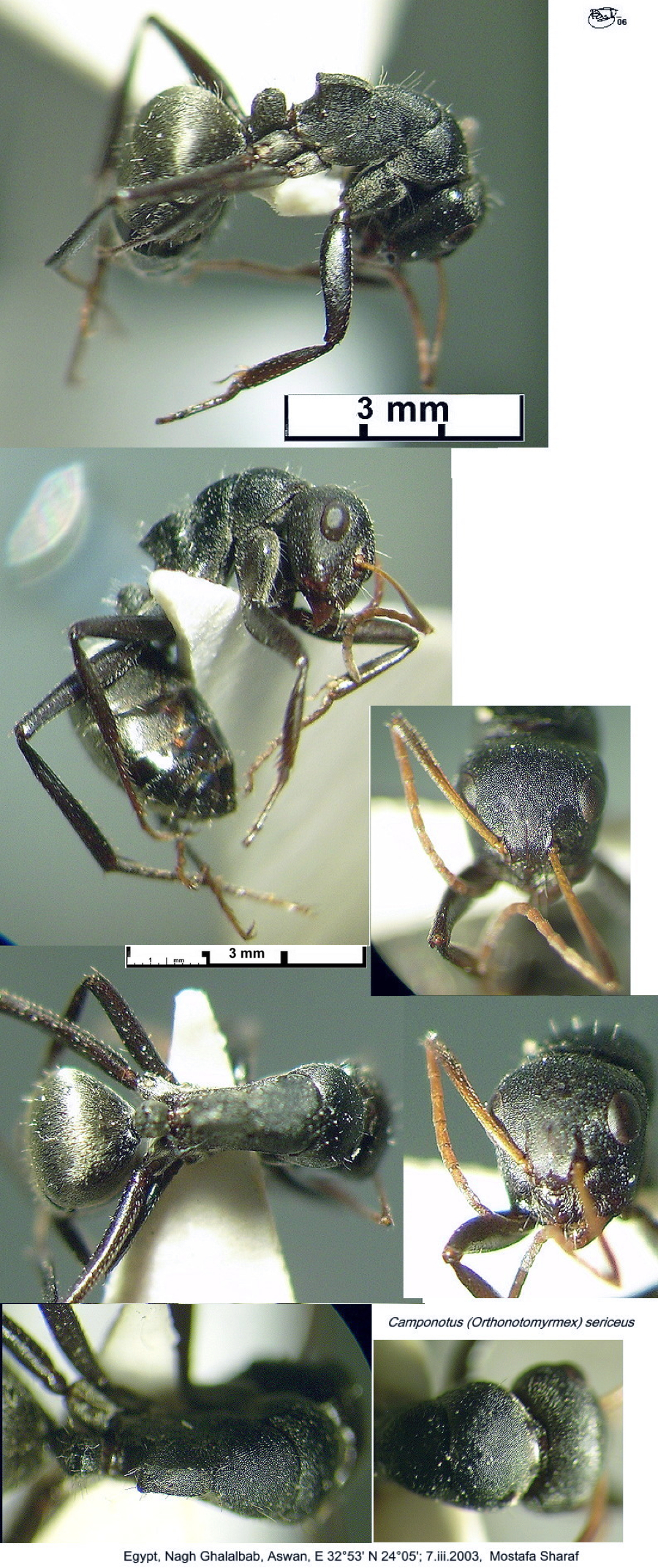 Egypt Records - Donisthorpe (1947e) recorded many
workers & soldiers from Siwa, Siwa depression, Tutuata, and Ultaba
Tarmarbas, J Omer-Cooper, iv-v.1935. Egypt Records - Donisthorpe (1947e) recorded many
workers & soldiers from Siwa, Siwa depression, Tutuata, and Ultaba
Tarmarbas, J Omer-Cooper, iv-v.1935.
Specimens photographed were collected at Nagh Ghalalbab, Aswan, E
32°53' N 24°05'; 7.iii.2003, by Mostafa Sharaf.
Sharaf list (combined with ? obtusus) - Material examined: Nagh
El-Ghalalab (Aswan), 7.iii.2003 (14); Masmas (Tushka), 16.ix.1997 (2);
Tekzarti (Siwa) (1), Agormi (Siwa) (1) Leg.Dr.Ahmed Saad (SHC). Dakhla,
6.ii.1953 (10); Gebel Elba (Eastern desert), 6.ii.1953 (1) (ASUC);
Gebel Elba, i.1930, Efflatoun (4 ?); Gebel Elba, i.1929, Efflatoun (1
worker) (CUC). Local distribution: Marsa Matrouh, Dakhla oasis (Finzi,
1936); Baharyia oasis, Faiyum, Kharga oasis, Siwa oasis, Kom Osheim,
Gebel Elba
|
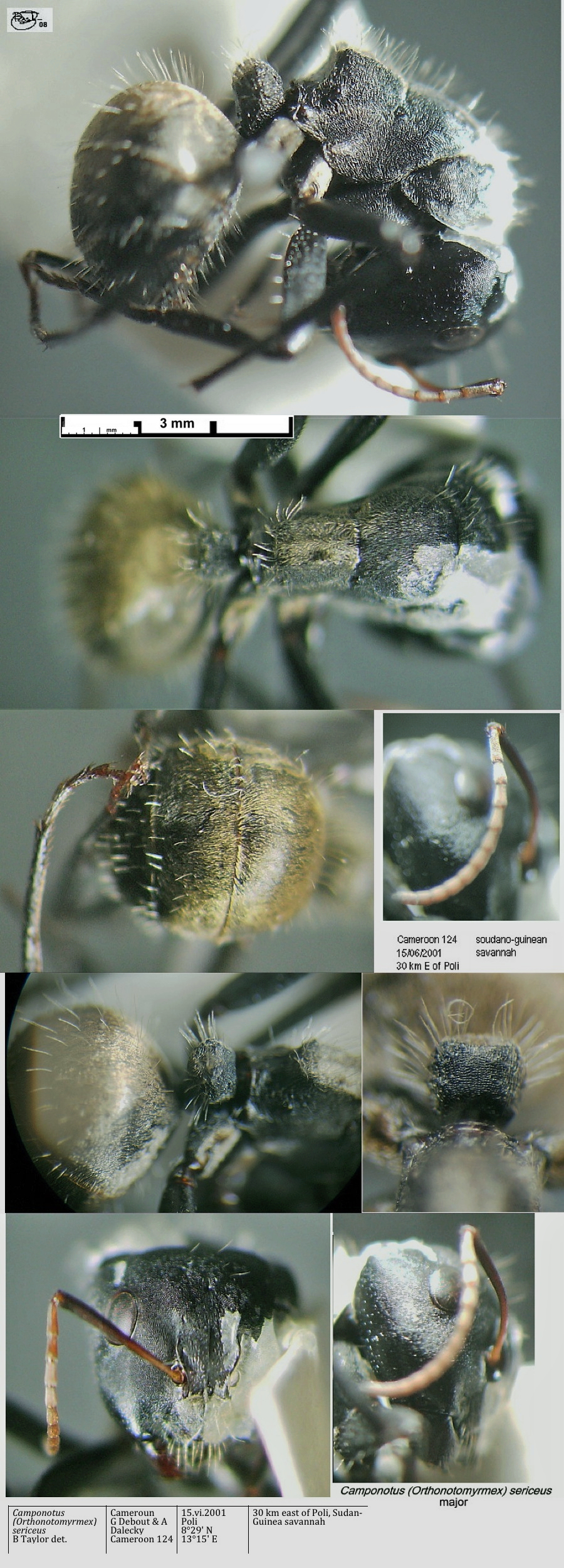 The photomontage is
of a major worker with a minor worker below,
collected in Cameroun - 30 km east of Poli (ca °29' N 13°29' E)
at a Sudan-Guinea savannah location (McKey Wolbachia project) -
Cameroon 124, 15 June 2001. The photomontage is
of a major worker with a minor worker below,
collected in Cameroun - 30 km east of Poli (ca °29' N 13°29' E)
at a Sudan-Guinea savannah location (McKey Wolbachia project) -
Cameroon 124, 15 June 2001.
|
 Photomontage of a
media worker from Burkina Faso,
collector
David King (King 93). Photomontage of a
media worker from Burkina Faso,
collector
David King (King 93).
|
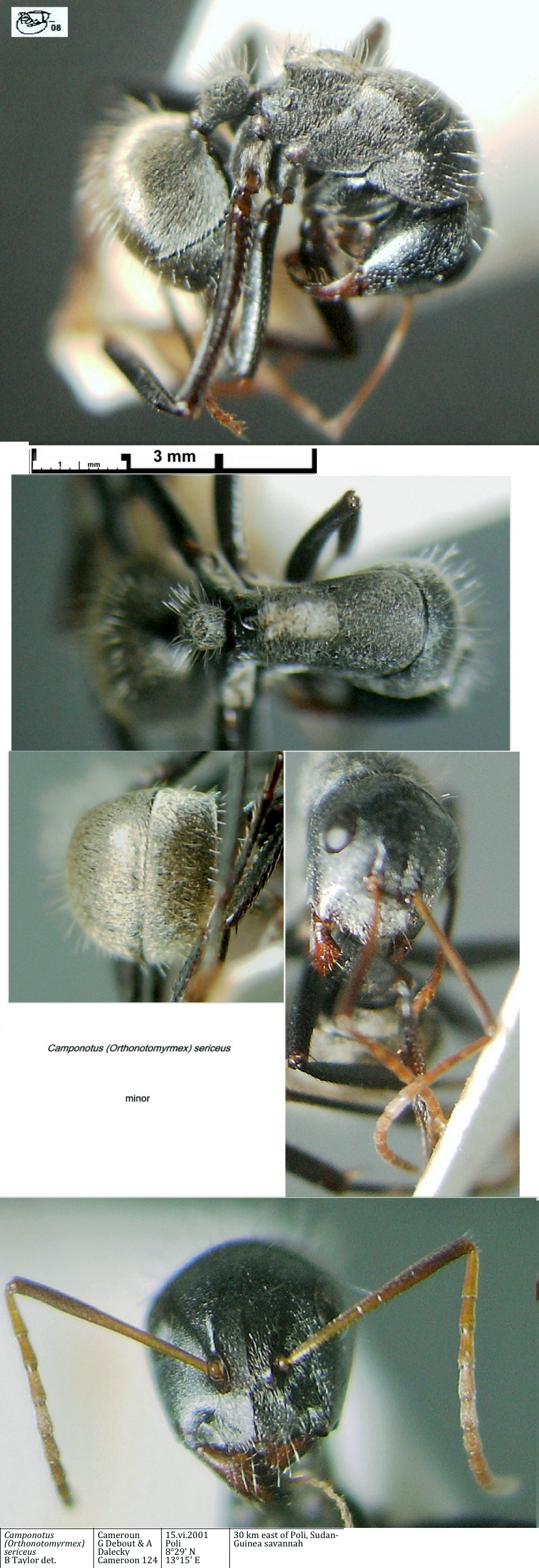 Minor worker from Cameroun
(details above). Minor worker from Cameroun
(details above).
|
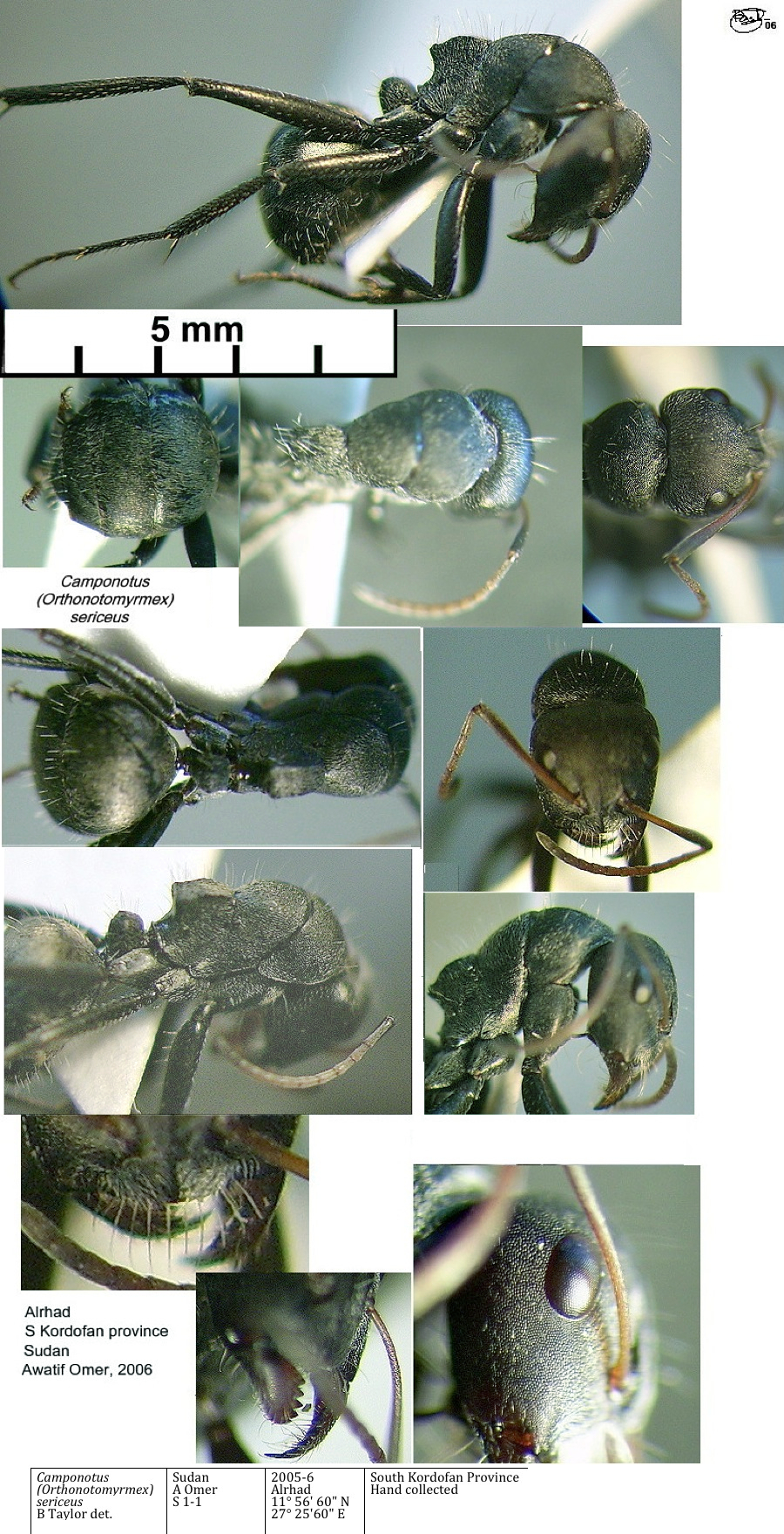 Photomontage
of minor workers from Sudan, collected by Awatif Omer. Photomontage
of minor workers from Sudan, collected by Awatif Omer.
|
|
Supplementary
Note
|
Camponotus (Orthonotomyrmex) sericeus
(Fabricius) -
status as in Bolton (1995: 123)
Type location Senegal
(Formica sericea, in Fabricius, 1798: 279, worker; Mayr, 1866b:
886, queen; Forel, 1886f: 192, male; Forel, 1891b: 56, all forms);
subspecies euchrous (Santschi, 1926b: 267, queen) from French
Sudan [western Sahel; not modern Sudan, as given by
Bolton], opaciventris (Mayr, 1879: 648, worker; junior synonym
Bingham, 1903: 376; revived from synonymy as variety, Forel 1908a: 6,
cited in Emery, 1925b: 126) from India, peguensis
(Emery, 1895k: 479, worker) from Burma (also igniceps,
as var of peguensis, Forel, 1913e: 664, worker, from Sri
Lanka), and sanguiniceps (Donisthorpe, 1942d: 458, worker) from
South India, and sulgeri (Santschi, 1913c:
313,
worker) from Congo;
junior synonyms aurulenta (Latreille, 1802c: 114, illustrated,
queen) from Senegal, obtusa (Smith, F., 1858b, worker)
from Egypt, and pyrrhocephala (Motschoulsky, 1863: 11,
worker) from Sri Lanka; all forms known.
|
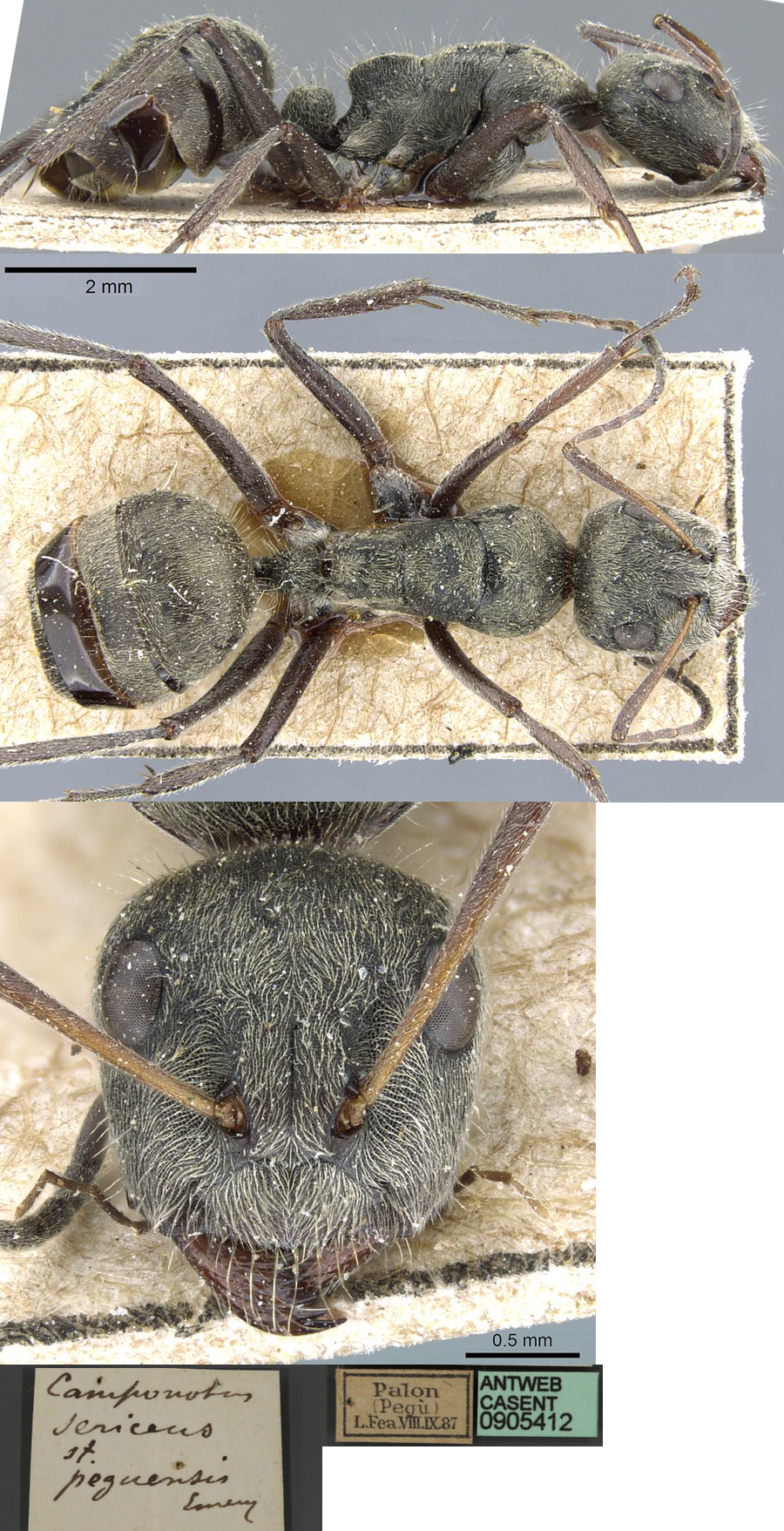 The
photomontage of a
type series minor worker of peguensis
from Myanmar (Burma) is collated from http://www.antweb.org/specimen.do?name=casent0010986. The
photomontage of a
type series minor worker of peguensis
from Myanmar (Burma) is collated from http://www.antweb.org/specimen.do?name=casent0010986.
|
|